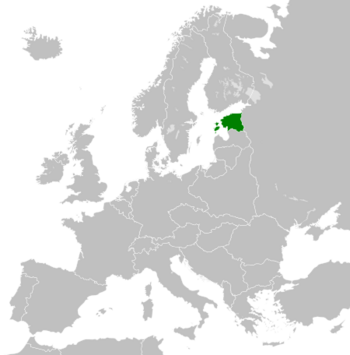History of Estonia (1920–1939) facts for kids
Quick facts for kids
Republic of Estonia
Eesti Vabariik
|
|||||||||||||
|---|---|---|---|---|---|---|---|---|---|---|---|---|---|
| 1918–1940 | |||||||||||||

Republic of Estonia within Europe (1929–1938)
|
|||||||||||||
| Capital | Tallinn | ||||||||||||
| Common languages | Estonian | ||||||||||||
| Government | Unitary parliamentary republic (1918–1934) Unitary parliamentary republic under a corporatist authoritarian dictatorship (1934–1940) |
||||||||||||
| President | |||||||||||||
|
• 1938-1940
|
Konstantin Päts | ||||||||||||
| Prime Minister/State Elder | |||||||||||||
|
• 1918-1919
|
Konstantin Päts | ||||||||||||
|
• 1920-1921
|
Ants Piip | ||||||||||||
|
• 1933-1934
|
Konstantin Päts | ||||||||||||
| Legislature | Riigikogu | ||||||||||||
| Historical era | Interwar and World War II | ||||||||||||
|
• Declaration of Independence
|
23 February 1918 | ||||||||||||
|
• Estonian War of Independence
|
28 November 1918 – 2 February 1920 | ||||||||||||
|
• Estonian Soviet Socialist Republic established
|
June 16 1940 | ||||||||||||
| Currency | Estonian kroon | ||||||||||||
| ISO 3166 code | EE | ||||||||||||
|
|||||||||||||
The history of Estonia from 1918 to 1940 tells the story of Estonia between the two World Wars. This time period began after Estonia won its Estonian War of Independence. It covers the years when Estonia was a democracy, faced a big economic crisis, and then had a period of strong, single-leader rule.
Contents
Becoming an Independent Nation
Estonia fought for its freedom in the Estonian War of Independence. They fought against both Soviet Russia and German volunteer groups. Estonia officially became independent with the Tartu Peace Treaty, signed on February 2, 1920.
Setting Up the Government
Estonia's first set of rules for its government, called a constitution, was approved on April 15, 1920. Estonia became a country where people voted for their leaders, known as a parliamentary democracy. The main law-making body was the Riigikogu, a parliament with 100 seats. The government was led by a "State Elder," similar to a prime minister, who had to answer to the parliament.
Gaining World Recognition
Many countries recognized Estonia as an independent nation. Finland did so in July 1920, followed by Poland in December 1920. The major Western Allies recognized Estonia in January 1921. In 1921, Estonia joined the League of Nations, an international group working for peace.
Building the Economy
Estonia quickly built strong trade relationships with many countries, including the Soviet Union. The country's economy relied heavily on selling farm products to Western countries. This was possible because land reforms created many small farms, ending the control of German landowners. A new currency, the Estonian kroon, was introduced in 1928.
Political Challenges and Culture
During the 1920s, Estonia's governments often changed because many political parties were in parliament. This made it hard for them to agree on things. Despite this, Estonian culture grew stronger. People focused on the Estonian language, history, and education. Minority groups in Estonia were also given the right to keep their own cultures.
In the early 1920s, communism was a concern, but it became less of a threat after a failed attempt to take over the government in December 1924. After this, a volunteer group called the Estonian Defence League was formed to help protect the country.
The Great Depression's Impact
Estonia's economy, which depended on exports, was hit hard by the Great Depression. This was a worldwide economic downturn. Factories and farms saw their production drop by 20% to 45%. As a result, people earned less money, many lost their jobs, and the quality of life went down.
This economic trouble caused political problems. The parliament became even more divided, and the government changed six times in just two years before 1933. Many people wanted to change the constitution to give more power to a president and less to the parliament. A group called the Vaps movement became very popular. They wrote a new constitution, which was approved by a public vote in October 1933.
A Time of Strong Leadership
In 1934, the economy started to get better. The value of the Estonian kroon was adjusted, which helped trade. With a new constitution approved and elections planned, political tensions began to ease. However, there was a chance that the Vaps movement would win the elections.
A Change in Power
To prevent the Vaps movement from winning, Konstantin Päts and Johan Laidoner led a military takeover on March 12, 1934. Hundreds of Vaps members were arrested. A six-month state of emergency was declared, meaning elections were postponed and political meetings were banned.
In 1935, Päts created the Patriotic League. This became the only legal political group in Estonia. Päts wanted to organize the country by people's jobs and skills, rather than by political parties. This was a similar idea to what some other European countries were doing at the time. In 1936, Päts held a public vote to create a new assembly to write another constitution.
Neutrality and World War II
Estonia tried to stay neutral, meaning it didn't take sides in conflicts. However, Estonia's future during World War II was decided by a secret agreement between Germany and the Soviet Union in August 1939. This agreement, called the Molotov–Ribbentrop Pact, divided up countries between them. Estonia was placed in the Soviet Union's "sphere of influence," meaning the Soviets had control over it.
After Germany invaded Poland, a Polish submarine, ORP Orzeł, sought shelter in Tallinn. But it escaped after the Soviet Union attacked Poland in September 1939. The Soviet Union accused Estonia of helping the submarine escape and claimed Estonia was not neutral. On September 24, 1939, the Soviet Union threatened Estonia with war. They demanded to set up military bases in Estonia, and the Estonian government had to agree.
Estonia's Downfall
In 1939, the Soviet Union forced Estonia to sign a mutual assistance treaty. This allowed the Soviet Union to establish military bases in Estonia. This agreement eventually led to the Soviet occupation of Estonia in 1940.



